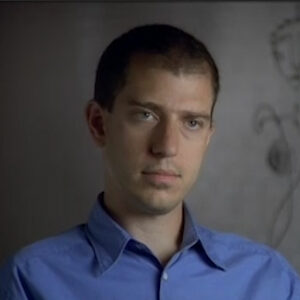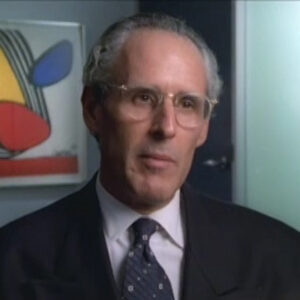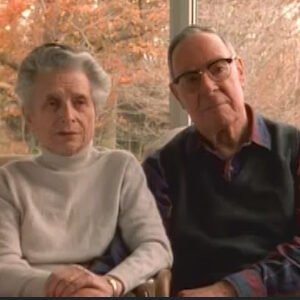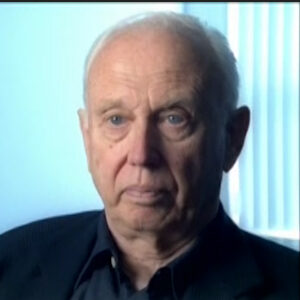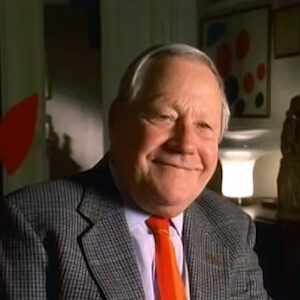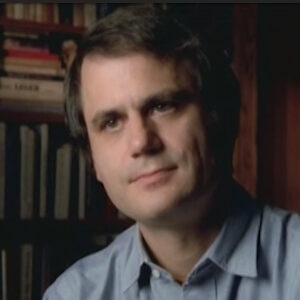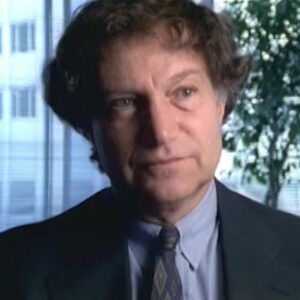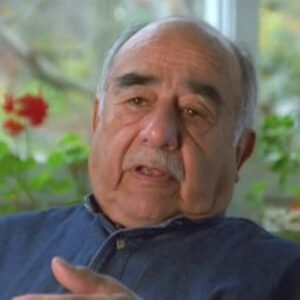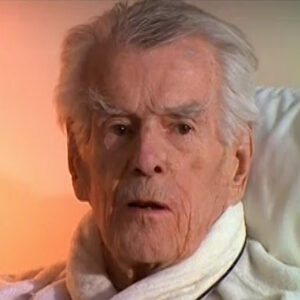Interviewer: Sculptor of kids toys,.
Joan Marter: Caulder is.
Interviewer: Don’t look at the camera. OK.
Joan Marter: Calder is one of the most innovative sculptors of the 20th century. He brought motion two sculpture and developed the idea of motion in his work for decades. He is also a major contributor to public sculpture in this country. And I think he undoubtedly he goes down in history as one of the greatest figures of the 20th century and sculpture.
Speaker Thank you. Let’s go all the way back. Give me the briefest of histories of his family. Grandfather, where it is. Where does he come?
Joan Marter: Caulder comes from a long line of artists, beginning with his grandfather, Alexander Milne Calder, who came to this country from Scotland in the 19th century. He was the designer of a major statue on the top of City Hall in Philadelphia. And he also made all of the sculptures of the whole sculptural decoration for that building. His father, Alexander Sterling Calder, was also a sculptor of note. He is responsible for a large figure of George Washington that can be seen today in Washington Square Park in Manhattan. His mother was also an artist. She was a painter.
Interviewer: Let’s cut for a second. Who is Louisa?
Joan Marter: Louisa was the niece of Henry James. She came from a literary family that had settled in New England. She was also an aspiring artist and she met Calder in the late 1920s.
Joan Marter: She was just in case Louisa.
Speaker Louisa James Calder, his wife.
Interviewer: You gotta give a.
Joan Marter: OK, Louisa James Calder, his wife, was an inspiring artist who was the niece of Henry James and she and her family had settled in New England. She met Calder in the late 1920s.
Interviewer: Was Calder rejecting his father, his grandfather. He also talked about the public sculptors.
Joan Marter: Calder’s grandfather and father were both creators of public sculpture. And he I think he learned from them how to work on a public site, how to work with architects, how to design for large space. On the other hand, they were both figurative artists. And he expanded in a direction far beyond them to explore the use of abstract forms on a public on a large scale.
Interviewer: Do you think he was rejecting them?
Joan Marter: I think that we could say with his father, who was a very serious artist, that Calder saw that he wanted his work to be more cheerful, more casual and lyrical, then his father’s work had ever been.
Interviewer: Why do you think he went to Stevens?
Joan Marter: Calder went to state the Stevens Institute of Technology to study mechanical engineering, and he from his childhood, had been interested in working with objects and tinkering with machines of various sorts. And he decided that he would like to explore engineering, really making a separation from the family tradition of acts of continuing in art. And he was actually very pleased with his study there in engineering.
Interviewer: But it didn’t take me one second.
Joan Marter: After a series of unfulfilling jobs where he was attempting to use his engineering, he decided to give up the prospect of becoming a mechanical engineer for the rest of his life. And he turned to something that he really wanted to do, and that was to be a painter. And he decided to enroll at the Art Students League to study painting and drawing.
Interviewer: Tell me it was nineteen twenty three and tell me about the work. Very briefly that he does there. It’s not an original but it does show signs.
Joan Marter: In 1923, Calder enrolled at the Art Students League, where he studied with a number of artists who were known for realist painting. And he himself started doing studies of New York City of Sports events.
Interviewer: Sorry, you’re still running. From a number of realist.
Joan Marter: He studied with a number of realist painters, and he took as his subject also the city of New York City, scenes of very, very scenes of the city and also sporting events that were taking place here. He was particularly interested in the circus.
Interviewer: Was it good? Was it your. Your answers are almost too short. You can relax a little.
Joan Marter: All right. His paintings were realistic depictions of the city, but they were very colorful, lively overviews of the city. Painted with broad brush strokes and vivid colors.
Interviewer: Good. Bad. Do we see?
Joan Marter: We see that these are actually student works. He looks very much like John Sloan, one of his teachers. And it’s more in the subject matter, especially in his depictions of circus and sporting events, that we see something of the Calder that is to come.
Speaker You say in your book, except for his shyness, he might have been actor.
Joan Marter: That’s his father. No, that’s his that’s his father. Yes. Yeah. .
Interviewer: When did call you. I’m sorry. When did Calder go to Paris to meet there? Tell us. It was the center of the art world.
Joan Marter: Calder decided to go to Paris in 1926. His friends had told him that he should go there. And in fact, it was very typical for young art students, American art students, to wish to go to Paris at that time. And when he came to Paris, he encountered a number of interesting artists, some of them Americans who were already there, and some European artists who befriended him and helped him to develop his own approach to his art at that time. Among Calder’s friends, when he in his various trips to Paris and he made a number of trips in the late 1920s, he developed a close friendship with John Miro. He also was friendly with Pescara. He was very good friends with Stanley, William Hader and Hosain to craft.
Interviewer: Just I’m sorry.
Joan Marter: Excuse me for a moment. OK.
Interviewer: Three, describe the Mondrian studio experience.
Joan Marter: Cader went to visit Mondrian in 1930. And more important, perhaps, than seeing Moldavians paintings in the studio was Calder’s experience of the studio itself. When he saw Mondrian studio, he found an environment where the walls were painted white. This trim was black and everything in the room had been painted in primary colors, including the Victrola. He was fascinated by pieces of cardboard that that Mondrian had mounted on the walls and that could be moved around at will. And what was very clear was that Mondrian’s art had expanded into the room and that his studio itself was a complete artistic statement.
Interviewer: What about this? This vibration, this isolation,.
Joan Marter: Calder said to Mondrian that he thought it would be fun if some of the cardboard rectangles that he saw on the walls could oscillate and Mondrian said, my painting is already very fast. But Calder clearly took away from from this the studio experience, the idea that this environment could be made to vibrate or move in certain ways.
Interviewer: And so he went back.
Joan Marter: Calder went back to his studio, and for a few weeks he decided he would try to make paintings in the style of Mondrian. This was new for him because before that time, he had not worked in an abstract style. He’s decided first to make oil paintings, but very soon he was making constructions. He was using a variety of materials, as he had in the late 1920s, to make his wood and wire figures. But this time he was using these materials to make abstract compositions.
Interviewer: Forty three. OK. So you only do that for a while. What’s next?
Joan Marter: After Calder made a few constructions that seem to be very close to Mondrian in style. He expanded his interests to the cosmic forms that we’re going to occupy him actually for many decades to come. He started making spherical compositions, ones that were based on both geometry and also his interest in planetary bodies. And these account for his earliest motorized devices that he was making in the early 1930s.
Interviewer: And he was working what for?
Joan Marter: He was using wire. Sometimes he would attach wooden forms, wooden spheres, for example. And at times he would also later use a motor. On these pieces, let’s cut.
Interviewer: Let’s cut. What are wire portraits? How dio they work?
Joan Marter: Calder would sometimes have a subject sit for him. And somehow he was able to take a piece of wire and make a drawing out of it. But it wasn’t just a line drawing in space. It was a Three-Dimensional Likeness of the individual. One of the amazing things about the wire portraits is the fact that they embody the person’s head, that they are Life-Size. And somehow he manages to create a likeness of a particular individual just using a few pieces of wire. It’s remarkable.
Interviewer: So we’re back. We’re back. That’s perfect, this is exactly where I want to go. So. What was that first and how did he develop? Did he create something and just stick with it and repeat himself? Now and then I figured this out. I’m going to do a thousand of these on the same.
Joan Marter: Calder was always looking for new things, new ideas, new ways of approaching art. And after he made animals and wire and wood and introduced different materials, after he made portraits, he would move on to something else. He was an innovator. He was someone who was interested in invention. And he was always looking at the world around him, primarily at animals and human beings. But secondarily, I would say all forms of nature and figuring out ways to depict the world around him. Eventually, it was in an abstract way that he was making these depictions.
Interviewer: Does anything come to mind where you know. The process of how he moved from one to another, first he made. Done this, and then a year later, he was doing this to show us his.
Joan Marter: Unfortunately, unless I become very specific, I can’t I can’t do that,.
Interviewer: Well you can be specific. I just want to know how you feel about it too.
Joan Marter: I would. All right. In the 1920s, for example, Calder was interested in animal forms from the circus. He would show rearing stallions. He would depict. Various circus creatures, elephants and others. And also he went to the zoo. But as he continued later in his career, we find these animals reappearing. But now they are made of sheets of metal. And part of them moves. It might be that it’s an elephant with a moving trunk or it could be a seal that balances a ball on top of its head. But always it is some form of nature, some animal, some performing creature, and a sense that lies behind the abstractions that he creates.
Interviewer: It almost sounds like it’s becoming less serious but obviously he’s more serious. Can you explain that?
Joan Marter: Calder in the nineteen thirties was making a major transformation in his work from a figurative style that was based on circus figures and toys and was in fact very humorous to a much more serious statement about compositions in Motion. Conetta CISM for its own sake. As he evolved further, he started to look again at some of the forms that he had developed earlier and as as an interest. And when he returned to these things, they were in large scale, very monumental in some cases, and very serious works indeed.
Interviewer: So what’s so special with the circus? It just seems like a quaint. It doesn’t seem new to me. Well, here I am, a 1997.
Joan Marter: In the late 1920s, in the late 1920s, the hot ticket in Montparnasse was an evening at Calder’s studio and a chance to witness the circus that he performed. He had records that were played to introduce the numbers. He would get down on the floor and manipulate the wire and wood and cloth figures himself. And people would gather in a very small space on orange crate bleachers to witness this grown man making animal sounds and delighting them with trapeze acts, tightrope performers and acrobats. The highlight of the show was a trapeze artist who swung from rope to rope and was caught by another trapeze performer. So it was a remarkable event and circus performers themselves. Critics of the circus and artists came to witness these performances.
Interviewer: Did he really singlehanded invent an art form?
Joan Marter: The mobile?Calder was not the only artist to introduce Motion into his sculpture. In fact, the futurists in the early 20th century had been interested in motion, as had Mohali Nage. The difference in the case of Calder is that he developed his ideas about kineticism. The difference the difference in the case of Calder is that he developed his ideas of kineticism through several decades and they became the standard signature approach for his art. His idea of the mobile was developed, expanded and enlarged to the scale of something that could fill a space in the National Gallery of Art.
Interviewer: And was this special in the world of art? Does this make any difference to us?
Joan Marter: Calder’s use of motion in sculpture and his exploration of the various ways in which motion can appear in his work separates him from most artists of the 20th century. He has brought a new approach to sculpture to us for all the decades of his life. For 50 years, really.
Interviewer: You talked about. About sculpture, a static work versus non static work motion. And random motion. Not about being not about shapes and colors. About how he brought it to life. Can you. I can read you your your quote. But could you. Could you do that again? Would you like me to tell you what you said.
Speaker Yeah.
Speaker Let’s cut for a second. So what about motion?
Joan Marter: Well Calder had the idea that sculpture didn’t have to be about colors and shapes alone, but they could actually be about composing motions, that a variety of motions could be included in the same work. And he set about doing this first by using motors. But eventually he had the idea that sculpture should be able to move on its own, that someone could go up and push the piece or could be caught up in a gust of wind. And the piece would move randomly. And this would create a whole variety of interactions among the forms that he was employing in the sculpture. It was a very inventive idea.
Interviewer: What do you feel when you see this stuff happening?
Joan Marter: When I see a Calder, I see that he is very much attuned to nature. He is aware of the fact that Brisas can change the appearance of a tree, that animals are constantly moving, that there are so many unpredictable random motions that we find in the world around us. And the sculpture seems to take on a life of its own. It comes alive and expresses everything about the world around us. It constantly surprises us. It amuses us. And when it is unpredictable, we find it even more enjoyable.
Interviewer: Let’s cut again. Because I’m.
Joan Marter: I feel that Leonardo da Vinci would have been very understanding if he had visited Calder’s studio because in the studio one could see that Calder was constantly experimenting. He was experimenting with motion. He was experimenting with various forms. He was always looking for some new approach. And oftentimes he would not be satisfied to simply repeat himself. He wanted to go on. He wanted to see the way it new materials would bounce with one another. He wanted to expand the scale of his work. He wanted to explore not just motions, but sometimes even sound in his sculpture.
Interviewer: Was it successful?
Joan Marter: Calder. From the time he was a little child, was interested in it from the time Calder was a little child. He was interested in making very amusing objects. And as he developed into his early artist period, he, for example, made himself a sundial that was actually a rooster that had feet that spread out in different directions to signal the hours of the day, to correspond to the hours of the day and called or oftentimes would amuse his friends and also give them amusing gifts as a memento of a visit. One time, Calder visited Hosie to craft in his Parisian studio, and he disappeared into the other room for a while. And when he emerged, he had made a wire dog over one of the faucets of the sink. When the faucet was turned on, the wire dog lifted its leg. And Calder oftentimes would make belt buckles for people. He also made wire earrings. He was constantly looking at ways to make people laugh through his figurative sculpture, particularly, but also his animal figures.
Interviewer: What was it like going to his studio? What was he like there?
Joan Marter: Calder was very fun loving at his studio. He was very interested in talking. In a very casual way, not to specifically and not too seriously about his work. He was interested in recollecting about the past, about people that he knew about works that he had created years ago in a not too specific way. But he was always laughing and always amusing.
Interviewer: Did he show you work? Talk to me what happened when you walked into his studio.
Joan Marter: When when one walked into Calder’s studio.
Interviewer: When you walked in.
Joan Marter: When I walked into Calder’s studio, I was amazed at how many objects were there and how messy it was, how. It was very much a work in progress. How there were wires and tapes everywhere. How? There was wooden parts of wooden sculptures. And how one always had the idea, looking at all of this, that the artist was constantly working, constantly inventing new forms. And going back in some cases to earlier works that he had created. He was somewhat casual about his work. I would say he would make jokes about it. He would tease in a sense about the things that he had created.
Interviewer: What did what did you. What did he talk to you? What was he interested in? Is there a story, anything that from the time you.
Joan Marter: Yeah. When I was talking to Calder was mostly about his early years. And he told me stories about people that he knew from that time. He looked at photographs of works that he had created early on and in some cases told me stories in connection with specific works.
Interviewer: Any stories that were good that we should know about? That come to mind. Let’s roll. What a contribution.What is the contribution of stabiles? How does that fit into the whole history of public sculpture, sculpture of the time in the 20th century. Ok.
Joan Marter: I think Calder’s stockpiles are one of the major developments in 20th century public sculpture. I think Calder has made a lasting contribution to the urban landscape. When we see these large, abstract, brightly colored forms on public sites, they are exciting, dynamic, large scale abstractions. They vitalize the space where they are located and they are a lasting tribute to his invention.
Interviewer: How should be remembered?
Joan Marter: Calderneeds to be remembered as the creator of the mobile, one of the great developments in the 20th century, because it’s so much a part of 20th century life. Life in the 20th century is about motion. It’s about speed. It’s about change. And that’s what Calder embodies in his work. Caldas should also be remembered as a major contributor to a new direction and public sculpture. The creation of abstractions, 50 foot, 60 foot in scale on public sites. He opened up the possibility for many artists to use new materials to use large scale abstract forms and to make a statement in the public arena.
Interviewer: What about this transformation from figurative to abstract? Does he have any place in that?
Joan Marter: Calder has a major place and a change in our concept about public art in the past. We always thought that public art had to be a figure that was either an allegorical figure or commemorative statue of a public person. A famous individual Caulder showed us that the public work can be, in fact, a lyrical abstraction. It can be a large scale form that is brightly colored, that does not really represent anything in particular, but that carries with it a kind of vital spirit of the world around it.
Interviewer: In a storm key lately?
Joan Marter: Yes.
Interviewer: Describe to me what the experience of seeing different.Whats that experience for you?
Joan Marter: Calder’s work works marvelously in a an outdoor site. Because it is influenced very much by the environment that surrounds it. It is transform, one might say, by the light that plays on it in various places. It also can be seen to great advantage from close up. It can be experienced directly by, in some cases by walking beneath it, or it can be seen at a great distance as a kind of abstract shape on a rolling hillside.
Interviewer: Let’s cut. I think we’re done. Who was Calder? Why should we care?
Joan Marter: Calder was one of the most innovative sculptors of the 20th century. He introduced new ideas, new concepts to the creation of sculpture. Both small scale works and public works. Calder introduced movement to sculpture in a systematic way, and he continued to explore it over many decades. For that alone, he is worthy of our consideration. He is one of the most humorous, but at the same time one of the most profound innovators of the 20th century.
Interviewer: What does he mean to you? Has he changed your life?
Joan Marter: Calder changed my life because I came to know his work. When I was a young student, I taught about Calder to the earliest classes that I had.
Interviewer: But how did he change your life?
Joan Marter: He changed my life because in. But he changed my life in a direction of really becoming more and more devoted to the study of sculpture. Among other things, because I have gone on to explore not only his work for many years, but also many other artists as well.
Interviewer: What about the man? Tell me about the man.
Joan Marter: Calder. According to me.
Interviewer: Yeah.
Joan Marter: Calder taught us that there was always a place for humor in art, that the artists did not have to look to the past and create monuments that were based on the memorial. But in fact, the artist could be constantly inventive. He could bring sculpture forward in time, introduce some of the latest developments and abstraction, explore a full range of colors and shapes and sizes and materials using, of course, industrial materials and make sculpture a thing of its time.
Interviewer: Thank you. Let’s cut. Great Calder.
Joan Marter: When I see a great Calder in a public space, I am overwhelmed by its scale, but also by the way that it transforms the world around it in an environment that is. taken up by very dull and predictable office buildings.


